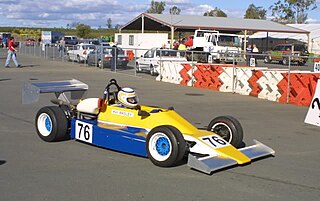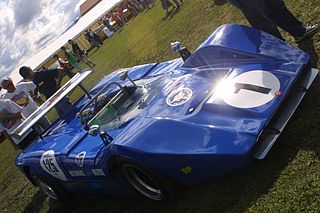Related Research Articles
The 1983 Australian GT Championship was a CAMS sanctioned Australian motor racing title for cars complying with Group D regulations for GT cars, with Group B Sports Sedans competing by invitation. It was the sixth Australian GT Championship. The championship was won by Rusty French, driving a Porsche 935.
The 1986 Australian Drivers' Championship was a CAMS sanctioned Australian motor racing title for Formula Mondial racing cars. It was the 30th Australian Drivers' Championship. The championship winner was awarded the 1986 CAMS Gold Star.

The 1984 Sandown 1000 was an endurance motor race staged at the Sandown Raceway in Victoria, Australia on 2 December 1984. It was the eleventh and final round of the 1984 FIA World Endurance Championship and was the first FIA World Championship race to be held in Australia. It was to be the first of a three-year contract to race at Sandown, though the final two years would be cancelled.
The 1984 Australian Sports Car Championship was an Australian motor racing title open to Sports Cars complying with CAMS Group A regulations. It was the 16th Australian Sports Car Championship.

Kaditcha was an automobile manufacturer in Australia. The company, formed by Queensland engineer Barry Lock, made open wheel and sports car racing cars, including cars for Formula 5000, Formula Pacific and Australian Formula 2.
The 1982 Australian Touring Car Championship was a CAMS sanctioned Australian motor racing title open to Group C Touring Cars. It began on 18 February 1982 at Sandown Raceway and ended on 16 May at Oran Park Raceway after eight rounds. The title, which was the 23rd Australian Touring Car Championship, was won by defending champion Dick Johnson, driving a Ford XD Falcon.

The 1983 Australian Touring Car Championship was a CAMS sanctioned motor racing title for drivers of Group C Touring Cars. The title, which was the 24th Australian Touring Car Championship, was contested over a series which began on 6 February 1983 at Calder Park Raceway and ended on 19 June at Lakeside International Raceway after eight rounds.

The 1984 Castrol 500 was an endurance motor race staged at the Sandown Park circuit in Victoria, Australia on 9 September 1984. The event was open to Group C Touring Cars, competing in two engine capacity classes, Up to 3000cc and Over 3000cc. It also included a class for Group A cars which were to replace Group C cars in Australian Touring Car racing in 1985. The race, which was held over a distance of 503 km, was Round 3 of the 1984 Australian Endurance Championship.
The 1984 Australian Drivers' Championship was a CAMS sanctioned national motor racing title open to drivers of racing cars complying with Formula Mondial regulations.

Group A Sports Cars is an Australian motor racing category that CAMS formulated for sports car racing in Australia. Introduced in 1964, it continues today under the name Group 2A Sports Cars.
Alfredo Costanzo is a retired Italian born Australian racing driver. From 1980 to 1983 Costanzo won four Australian Drivers' Championships in a row, equalling the record set by Bib Stillwell from 1962 to 1965.
The 1985 Australian Sports Car Championship was a CAMS sanctioned motor racing title for drivers of Group A Sports Cars. It was the 17th Australian Sports Car Championship and the first to be run concurrently with the Australian GT Championship.
Allan Moffat Racing was an Australian motor racing team owned by multiple-championship winning Canadian-Australian racing driver Allan Moffat. The team was highly successful, winning races on three continents including three Australian Touring Car Championships in 1976, 1977 and 1983, four Bathurst 500/1000s including a memorable 1–2 victory in 1977, and the 1987 Monza 500, which was the inaugural race of the World Touring Car Championship.
The Romano WE84 is an Australian designed and built, mid-engined closed top racing car built to CAMS Group A Sports Car specifications. The car began its life as the Kaditcha K583 when it first appeared in the 1983 Australian Sports Car Championship and was built by the Queensland based Kaditcha owner and former McLaren engineer Barry Lock after he was approached by Brisbane accountant, property developer, timber mill owner and former speedway racer Bap Romano in 1981 with the idea of building a Le Mans type coupe. When the car first appeared in 1983, it was the first closed top Sports Car seen in Australia and looked like an FIA Group C Sports Car rather than the open cockpit Can-Am style cars of previous years. This led to the false belief that it was built to the Group C regulations
The 1982 Australian Sports Car Championship was a CAMS sanctioned Australian motor racing title open to Group A Sports Cars. It was the fourteenth Australian Sports Car Championship, and the first to be contested by Group A cars since 1975. The championship was won by Chris Clearihan of Canberra, driving a Kaditcha.
The 1986 Australian Sports Car Championship was a CAMS sanctioned Australian motor racing title for drivers of Group A Sports Cars. It was the 18th Australian Sports Car Championship.
The 1987 Australian Sports Car Championship was a CAMS sanctioned Australian national motor racing title open to Group A Sports Cars, Group D GT cars, FISA Group C1 cars and FISA Group C2 cars.
Christopher Alfred Clearihan is an Australian motor racing driver and Air Race pilot.
Romano Racing was an Australian motor racing team that competed in Australian V8 Supercar racing between 1995 and 2003.

The Veskanda C1 is a one-off, Australian designed and built, mid-engined closed top racing car built in 1985 to CAMS Group A Sports Car specifications. Powered by a Chevrolet V8 engine, the car is generally regarded as the fastest sports car ever built in Australia and as of 2016 remains one of Australia's fastest race cars.
References
- 1 2 3 CAMS Manual of Motor Sport, 1983, pages 91-94
- ↑ Australian TitlesRetrieved from www.camsmanual.com.au on 13 July 2009. 2009-07-22.
- ↑ Tiga Mazda - A Short Life! www.youtube.com
- 1 2 3 4 5 6 7 8 9 10 11 12 13 14 15 16 17 18 Barry Catford, Australian Sports Car Championship, Australian Motor Racing Yearbook, 1983/84, pages 242-253
- ↑ Death of a Tiga, www.youtube.com
- ↑ Graham Slater, Big bangers go crackers, Racing Car News, April/May 1983, pages 22 & 23
- 1 2 3 4 5 6 Barry Catford, Our Top Car of 1984 - Romano WE84 Cosworth, Australian Motor Racing Year 1984/85, pages 18-20
- ↑ TV ringside, Racing Car News, September 1983, pages 42 & 43
- ↑ Keith Roissetter, Hopwood heads home, Racing Car News, October 1983, pages 44 & 45
- 1 2 Official Programme, Adelaide International Raceway, Sunday, 1 May 1983
- 1 2 3 Program, Sandown, 20th Feb. '83